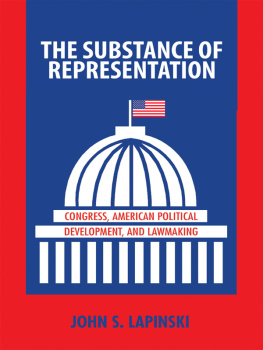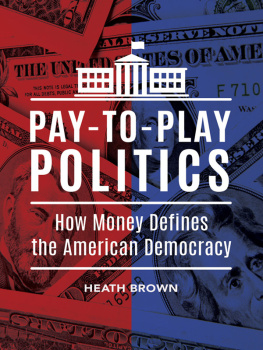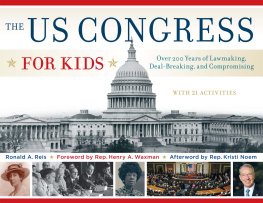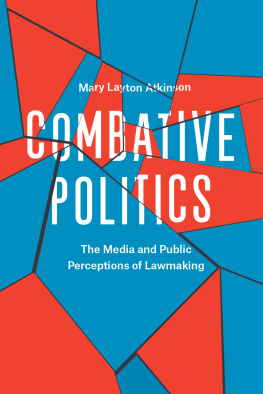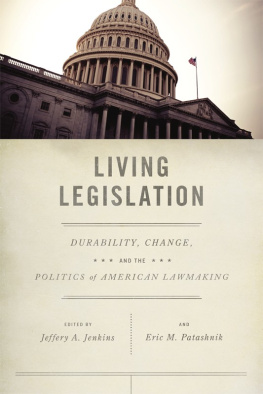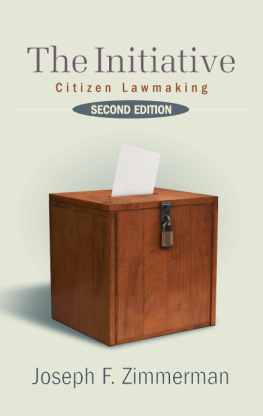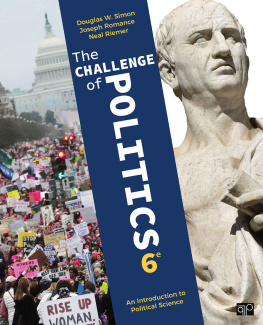
THE SUBSTANCE OF REPRESENTATION
PRINCETON STUDIES IN AMERICAN POLITICS
HISTORICAL, INTERNATIONAL, AND COMPARATIVE PERSPECTIVES
SERIES EDITORS
Ira Katznelson, Martin Shefter, Theda Skocpol
A list of titles
in this series appears
at the back of
the book
THE SUBSTANCE OF REPRESENTATION
CONGRESS, AMERICAN POLITICAL DEVELOPMENT, AND LAWMAKING
John S. Lapinski
PRINCETON UNIVERSITY PRESS
PRINCETON AND OXFORD
Copyright 2013 by Princeton University Press
Requests for permission to reproduce material from this work should be sent to permissions, Princeton University Press.
Published by Princeton University Press, 41 William Street,
Princeton, New Jersey 08540
In the United Kingdom: Princeton University Press, 6 Oxford Street, Woodstock, Oxfordshire OX20 1TW
press.princeton.edu
All Rights Reserved
Library of Congress Cataloging-in-Publication Data
Lapinski, John S., 1967 The substance of representation : Congress, American political development, and lawmaking / John S. Lapinski.
pages cm
Includes bibliographical references and index.
ISBN 978-0-691-13781-0 (hardcover : alk. paper) ISBN 978-0-691-13782-7 (pbk. : alk. paper)
1. United States. Congress. 2. LegislationUnited States. 3. United StatesPolitics and government. I. Title. JK1021.L37 2013
328.73dc23
2013013888
British Library Cataloging-in-Publication Data is available
This book has been composed in Minion Pro
Printed on acid-free paper
Typeset by S R Nova Pvt Ltd, Bangalore, India Printed in the United States of America
10 9 8 7 6 5 4 3 2 1
_____________Contents____________
__________________Preface___________________
IN WRITING THIS BOOK, I often thought about Sisyphus. In Greek mythology, he was the king who was punished by being forced to roll an immense boulder up a hill only to watch it roll back down. My metaphorical boulder involved collecting more data and creating better measures of lawmaking. Fortunately, I was not compelled to repeat this action forever (though it felt like it). Of course, I didnt make those trips up the hill alone. Many people helped me in this effort. Intellectually, the project began while I was a graduate student Columbia University. I wrote a paper for a graduate seminar taught by Ira Katznelson dealing with conceptual issues related to policy substance, the study of Congress, and American political development. Ira was already my dissertation chair at the time (along with Nolan McCarty, who was co-chair), but the paper was a critical juncture, as it led to a series of collaborations. Those collaborative projects have been instrumental to this book. Specifically, the coding schema in this book is based on our joint work. In addition to being a terrific co-author, Ira has influenced my own work in more ways than seem possible. His intellect and work ethic make him a truly inspiring individual. I owe him a great debt.
Many others deserve credit in the making of this book. Josh Clinton, a frequent co-author, was instrumental in turning my earlier work on measuring legislative significance into much more refined and sophisticated work. The legislative significance measure presented in is based on our collaborative efforts. He is clearly a partner in this project. There are others who also provided much good counsel. One of those individuals is David Mayhew. I had the good fortune to develop a relationship with David during my stint at Yale University. He is a scholar who provides inspiration and much good advice. His social science instincts are unparalleled, and his advice was instrumental for many of the concepts in this book.
There are countless other individuals to thank, including Scott Adler, Richard Bensel, Sean Farhang, Bryan Jones, Nolan McCarty, Sunita Parikh, Keith Poole, Rose Razaghian, Charlie Riemann, Eric Schickler, Wendy Schiller, Robert Shapiro, Stephen Skowronek, Rogers Smith, Charles Stewart, and Greg Wawro. I am also grateful for the workshop participants at Cal Tech, MIT, Columbia, Yale, NYU, and Brown. All served as wonderful audiences for different sections of this book. The National Science Foundation provided much-needed resources to complete the data collection in this book (award #0318280), as did the Institution for Social and Policy Studies at Yale University, the Brown Center at the University of Pennsylvania, and the Russell Sage Foundations Visiting Scholar Program.
This book required an army of research assistants to help in its making, and some of them were particularly important. David Bateman is a terrific PhD candidate and will soon make a fine professor. His contributions to the casework in this book made him a co-author of . Chris Brown is also an amazing graduate student. He is a collaborator of mine in other projects, but his help with this project was instrumental to finishing the book. Many of the earlier research assistants on this project have gone on to become professors at very good institutions or to pursue other fine careers, including Daniel Galvin, Matt Glassman, Christina Greer, Quinn Mulroy, Eldon Porter, and Melanie Springer.
I want to extend a special thanks to Chuck Myers, my editor at Princeton University Press. Chuck is an amazing editor. His guidance and encouragement led to a much better book. His patience is also extraordinary. I also want to thank the two anonymous reviewers: their comments were tough-minded, but again helped me make the book better. I would also like to thank Leslie Grundfest and Eric Henney of Princeton University Press. Finally, I thank my copyeditor Cindy Buck. Her excellent sense of style, combined with a sharp knowledge of the social sciences, made this book sharper and much easier to read. I really cannot believe my luck in being able to work with such a talented group of professionals.
Others have also helped in the writing of this book. The staff of Yales Institution for Social and Policy Studies, including Pam LaMonaca, Barbara Dozier, Pamela Greene, and Ella Futrell, provided an ideal work environment. They made me feel like I was staying at the Four Seasons Hotel every day.
The book is dedicated to my wife, Anjali Shaw. I would not have finished this book if it were not for her. She has always provided me with constant encouragement and timely advice throughout my career. Her intellectual prowess and no-nonsense approach to life have greatly contributed to any success I have achieved as an academic. In fact, I would not have pursued this career if it were not for her. I owe her a great debt, which will never be fully repaid.
THE SUBSTANCE OF REPRESENTATION
_______________Chapter I_______________
Policy Issue Substance and the Revitalization of Legislative Studies
WHEN LEGISLATIVE STUDIES EXPLODED in the 1960s and 1970s, many scholars took seriously the idea that policy issue substance was theoretically and empirically a very important consideration. During this earlier moment, scholars such as Theodore Lowi (1964, 1970, 1972), Aage Clausen (1967, 1973), David Mayhew (1966), and a young aspiring PhD candidate (and future Congress member and vice president), Richard Cheney (Clausen and Cheney 1970) were curious about how the types and content of issues under discussion shape political behavior and how lawmaking subsequently produces particular policy outputs. At the outset of this fertile period for legislative studieswhich would produce tremendous advances in systematic studies of Congresswork privileging policy issue content seemed poised for prominence, perhaps even predominance, within the subfield. The situation would quickly change, however, for reasons explored in this book. By the mid-1980s the substance-centered line of research was nearly nonexistent, and by the 2000s it seemed to have donned a cloak of invisibility.
Next page
